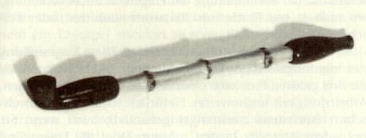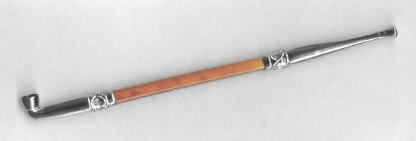|
Japanese kiseru pipes have a much smaller bowl than Western tobacco pipes.
The middle section is from bamboo or some other type of wood while the
ends are made from metal (often silver or bronze). This has revived the word
in a new meaning: The cheating on train fares in automated ticket gates by
paying (coins, metal) for two tickets for the first and last short sections
of a long trip and cheating (wood) on the middle section.

Bronze and ebony, Kyoto around 1780 (picture by H.G. Behr).
The name of the pipe is derived from the word ksher of the Khmer
language of Cambodia, a country where hemp has long been cultivated as
a drug and is still sold in public market places today. Though some
North Americans assume kiseru to be only usable for opium or hashish
smoking, they are in fact very suitable for marijuana and use it very
efficiently.

Bruyere wood and bamboo, Tokyo 1982. (picture by H.G. Behr).
Kiseru were also used for tobacco, of course, though not originally in
Cambodia.
Some kiseru are sold as "fashion pipes" at o-miyage (souvenir)
stalls in rural tourist locations.

"Fashion pipe", brass and bamboo, Kuroyamasantaki 1998.
See also:

 Hemp in religion,
for fibre, food and fuel,
marijuana,
as medicine
Hemp in religion,
for fibre, food and fuel,
marijuana,
as medicine

 Marijuana prices in Japan,
How many users,
The Hemp Control Law
Marijuana prices in Japan,
How many users,
The Hemp Control Law
|




